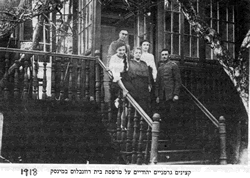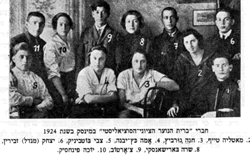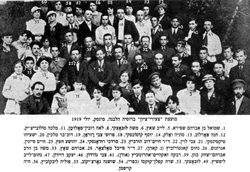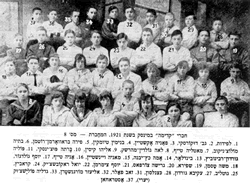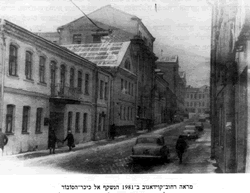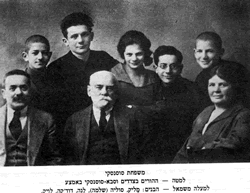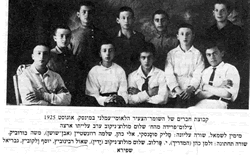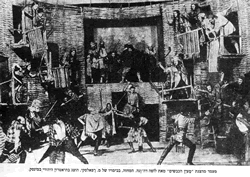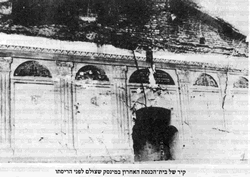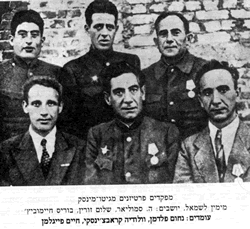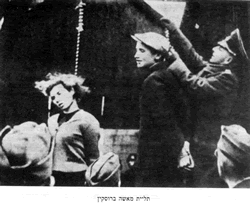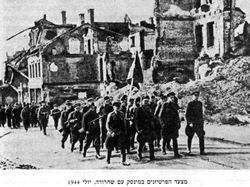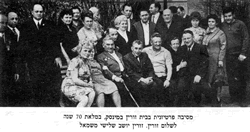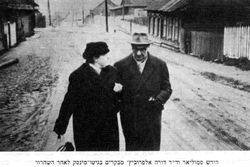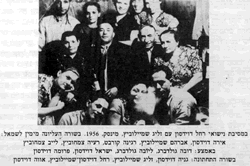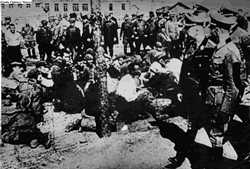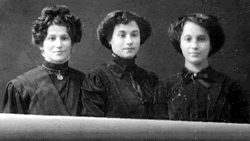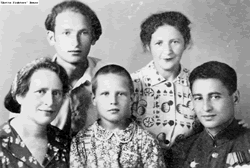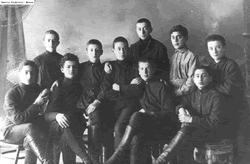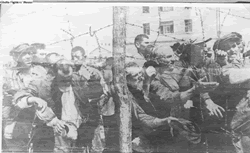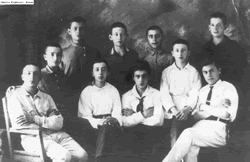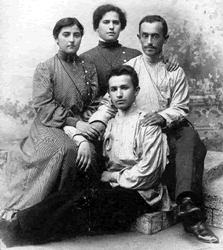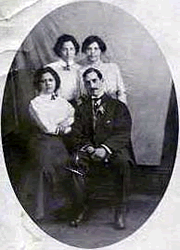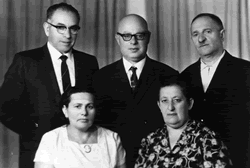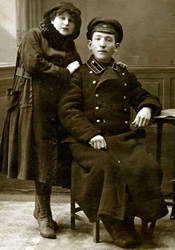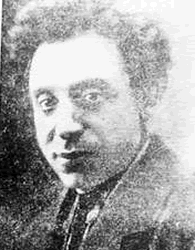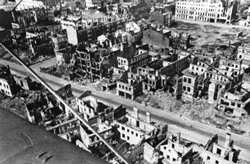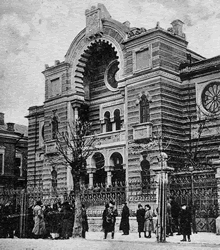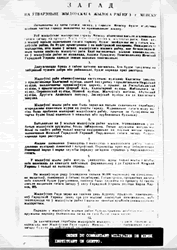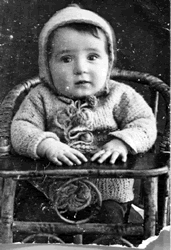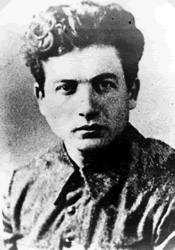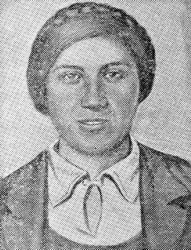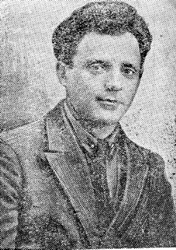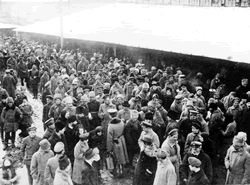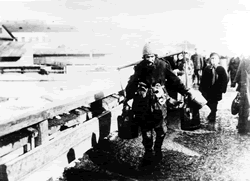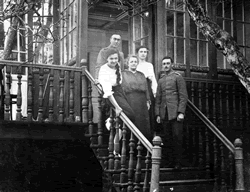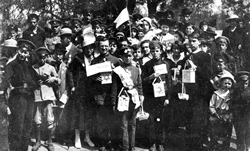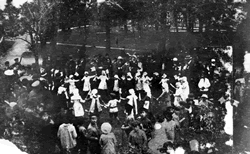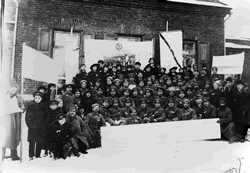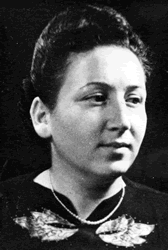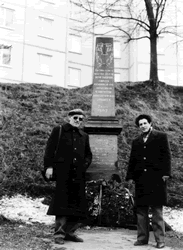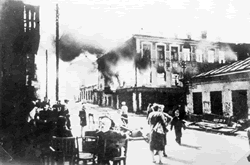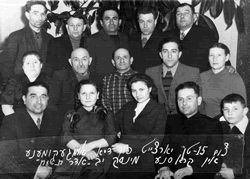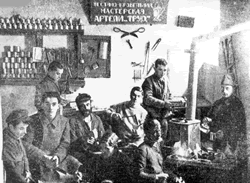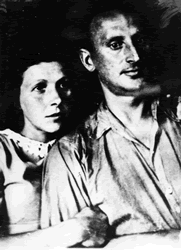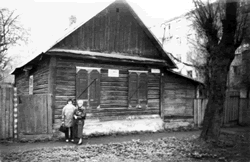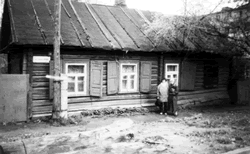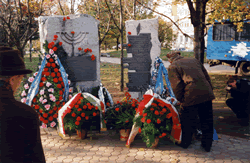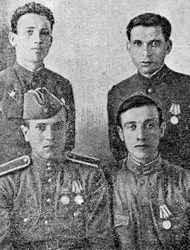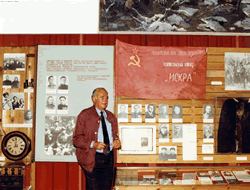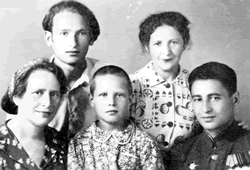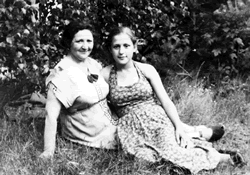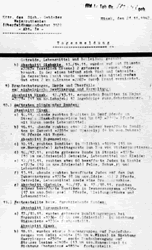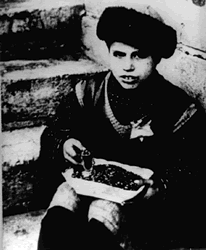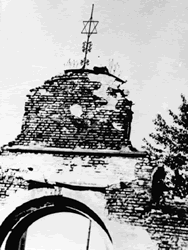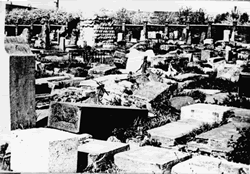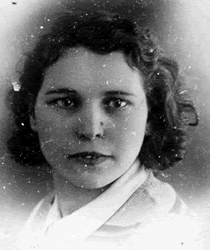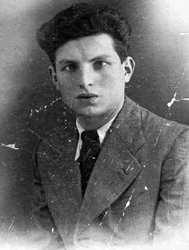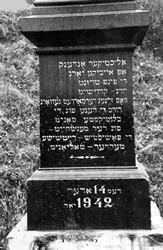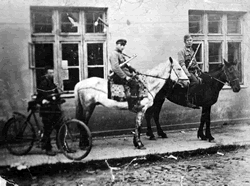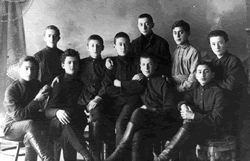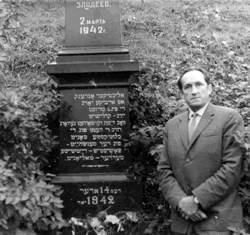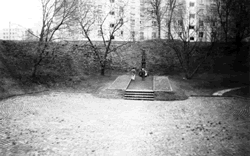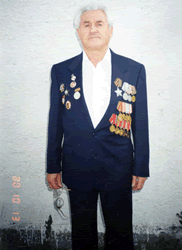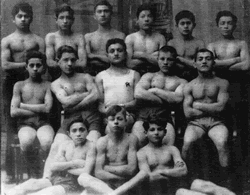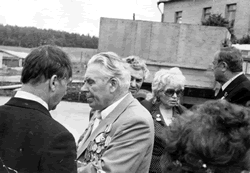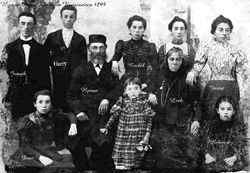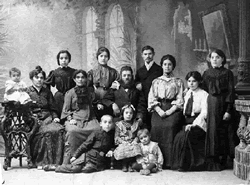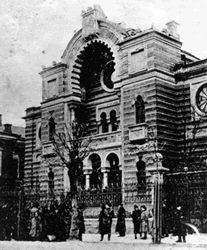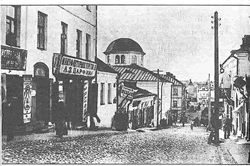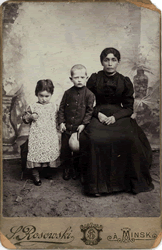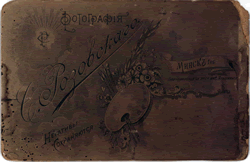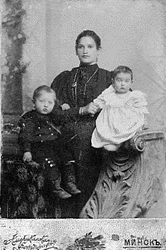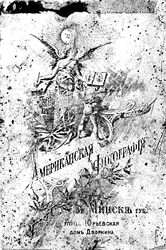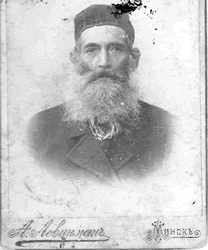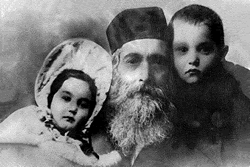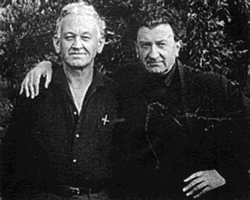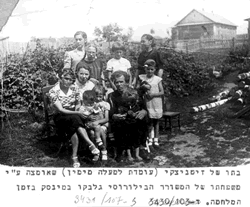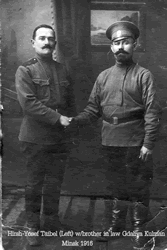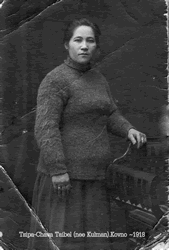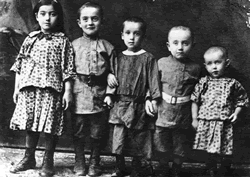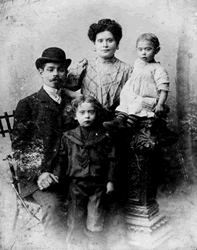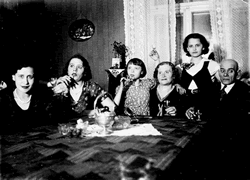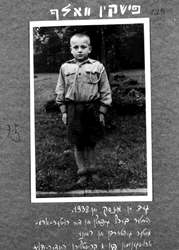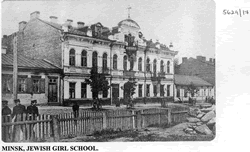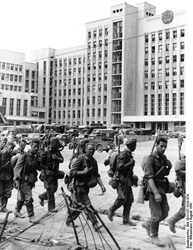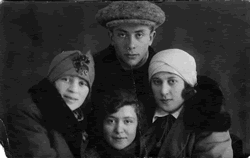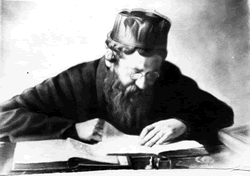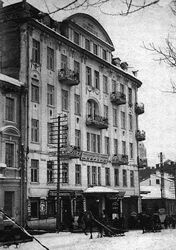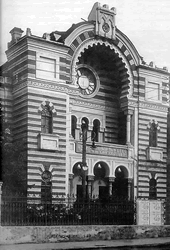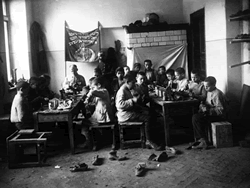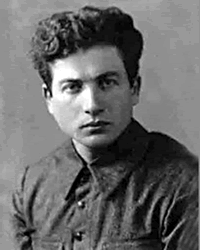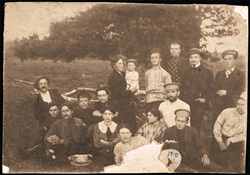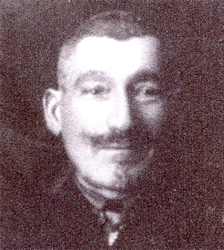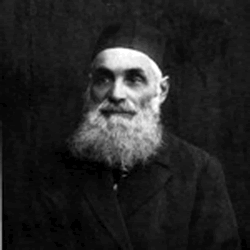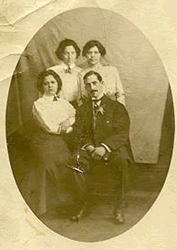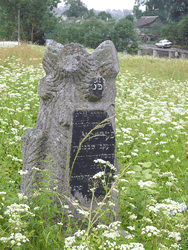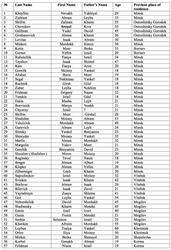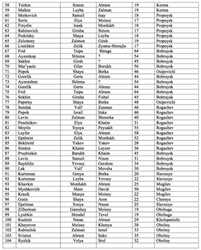Minsk, Minsk uyezd, Minsk gubernia
Latitude: 53º54' Longitude: 27º34'
|
#minsk-1: Members of the Rosenbaum family of Minsk with German Jewish soldiers during the German occupation of Minsk in the First World War |
#minsk-2: Socialist Zionist group in Minsk in 1924: 2. Matalia Taif 3. Chana Gurevitz 4. Emma Katz Yavne 5. Zvi Botvinik 6. Yizhak Mendel Zibrin |
#minsk-3: meeting of Zeirei Zion of Belarus in Minsk in 1919 (many named in the Hebrew caption) |
|
#minsk-4: Members of Kadima in Minsk in 1921 ( almost all shown are named in the Hebrew caption |
#minsk-5: Koidnov Street in Minsk |
#minsk-6: The Sosemsky family of Minsk- the family came to Eretz Israel and lived for awhile in Moshav Bitzaron. |
|
#minsk-7: Hashomer Hazair left in 1925 top from left; Melik Sosensky, Eli Cohen, Zvi Even Shoshan, Moshe Borovik, |
#minsk-8: A play "sheep's well" by the Spanish dramatist Lope De Vega directed by M. Rafaelski presented in the Jewish theater in Minsk |
#minsk-9: The wall of the last synagogue in Minsk ( Soviet times) before it was demolished |
|
#minsk-10: leaders of the resistance in Ghetto Minsk; Hersh Smolar, Shalom Zorin, Boris Chaymovitz |
#minsk-11: Masha Broskin was a Jewish partisan, member of the resistance in Minsk. She was hung by the Nazis. |
#minsk-12: The huge Victory parade of the partisans of the Vilna/ Minsk area. It took place in July of 1944. |
|
#minsk-13: A 70th birthday party for former partisan leader Shalom Zorin (sitting 3rd from the left) at his home in Minsk. Most of the guests were members of the resistance in the Minsk area. |
#minsk-14: Hersh Smolar and Dr. Dora Alperovits on a street in the Minsk ghetto. |
#minsk-15: The wedding party for resistance member: Rachel Davidson and Zelig Shmuelovitz, Minsk 1956. |
#minsk-16: Heinrich Himmler, the SS commander, touring the Minsk ghetto. One of the Jews on the other side of the ghetto fence has a circle on his chest. In this ghetto there was no Star of David but rather a yellow cloth circle, 10 cm. in diameter. Photographed in 1942. The Minsk ghetto had a section populated by Jews from Hamburg. At a certain stage the ghetto had no street signs, only numbers on the buildings. The ghetto's Jews, both locals and German immigrants, were required to wear a patch with their house number beneath the yellow circle. This decree was in force beginning in June - July 1942. |
#minsk-17: This photo was most likely taken in Minsk. I have no idea of the timeline or who these young ladies are. If anyone out there can help me please contact me.Sarah Greenberg sacredsisters3@aol.com |
#minsk-18: Two partisans and three underground members who came from the Minsk ghetto. In the photo: Chasya Proslina (on the left), Vladimir Shatzman (on the right), and Bela Proslina (second from the right). |
#minsk-19: Members of Ha - Tehiyyah, a Zionist youth movement in Minsk. Photographed in December 1925, prior to the emigration to Palestine of Shlomo Even Shoshan (seated, fourth from the left). Also in the photo: |
#minsk-20: A camp for Soviet POWs on Shirukuja Street in Minsk. This was initially a camp for Jews, and later became the principal camp for POWs in Minsk (in the Soviet army barracks). POWs were brought here, |
#minsk-21: Members of Ha - Tehiyyah, a Zionist youth movement in Minsk. Photographed in August 1925, prior to the emigration to Palestine of movement member Shalom Milechnikov - Yadin (seated, center). Also in the photo: Shlomo Even Shoshan (standing, second from the left). |
#minsk-22: This photograph shows my maternal grandfather, Meyer Cohen, lower right, with his siblings. It was taken in Minsk around the turn of the twentieth century. Chaika Cohen, my great aunt,and leader of Paoale Zion Minsk, is upper right. The other man may have been named Julius or Yudel Cohen or Kagan. The other woman may have been named Miriam Revekka or Rivka Cohen/Kagan. My grandfather Meyer immigrated to New York as did his sister Chaika, who married M.Y. Shelubsky, a Yiddish writer and publisher. I am trying to learn what happened to Yudel and Miriam. Does anybody recognize these people or their names? Miriam Camitta mpcamitta@aol.com |
#minsk-23: This photo shows my maternal grandmother, Rachel BASSEIN COHEN, seated, bottom left, with unknown people some of whom may be her cousins, or members of Paoale Zion Minsk. The photo was probably taken in Minsk around the turn of the twentieth century. Do you recognize any of these individuals? Miriam Camitta mpcamitta@aol.com |
#minsk-24: Do you recognize the man on the left? he must be GORDIN (or GORDON ). Gregory Engels |
#minsk-25: The Isaacsons in Minsk, 1920. For more information; 49&sn=2&sno=0&theme=7&source=ind&sourceID= 1000014&indID=1000014&sourceList= albumPage.php&albumID=0&view=restored: |
#minsk-26: Portrait of Shmuel Plavnik, also known as "Zimitrok Biadola," a well |
#minsk-27: Minsk at the end of the war ( summer of 1944) |
#minsk-28: The Great Synagogue of Minsk |
#minsk-29: A notice on the establishment of the ghetto in Minsk |
#minsk-30: Rosa Grinstein, a baby who perished in the Minsk ghetto on March 2, 1942. |
#minsk-31: |
#minsk-32: Nina Lis, a member of the Jewish underground in the Minsk ghetto. |
#minsk-33: Mordechai Proslin, a member of the Jewish underground in the Minsk ghetto. |
#minsk-34: A marketplace in Minsk during the period of the First World War |
#minsk-35: Jewish water carrier in Minsk before the war |
#minsk-36: the First World War- Members of the Rosenbaum family of Minsk |
#minsk-37: Jewish children and teens in a nature club in Minsk, celebrating the holiday of Lag B'Omer (late April 1918) |
#minsk-38: club in Minsk, celebrating the holiday of Lag B'Omer (late April 1918) |
#minsk-39: A convention of Jewish Russian army soldiers with Zionist aspirations |
#minsk-40: Bela Grinsztejn - Szuster of Minsk, a Jewish partisan in Belorussia. |
#minsk-41: A memorial monument in Minsk for 5,000 Jews massacred on Purim, March 2, 1942 |
#minsk-42: Burning The Nazis burning buildings in Minsk during the war |
#minsk-43: Members of the Holocaust survivor community from Krosno, photographed on the 15th anniversary of the killing |
#minsk-44: Members of a pioneering training group (hachshara) of the He - Chaluts movement in Minsk, working in the Trud tinsmithy |
#minsk-45: members of the resistance in the Minsk Ghetto who were able to escape to the forests. |
#minsk-46: A residential building in the area of the Minsk ghetto, that was refurbished and preserved by the municipality |
#minsk-47: A residential building in the area of the Minsk ghetto, that was refurbished and preserved by the municipality |
#minsk-48: A pair of stone pillars, a memorial monument to the Jews of Hamburg and Duesseldorf, Germany, who were deported to the Minsk ghetto |
#minsk-49: Partisans from the Minsk ghetto |
#minsk-50: Avraham Levit - Arluk, a former partisan, visiting an exhibit in Minsk commemorating partisan activities |
#minsk-51: resistance fighters from the Minsk ghetto |
| #minsk-52: Bela Proslina, a partisan from the Minsk ghetto, with her daughter |
#minsk-53: A report from the German security headquarters for northern Belorussia about activity and attacks by partisan units, Jewish and non - Jewish. |
#minsk-54: the Minsk ghetto |
#minsk-55: Ruins of the entrance gate to the Jewish cemetery on Sochaya Street in Minsk, USSR. |
#minsk-56: Smashed gravestones in the Jewish cemetery in Minsk, USSR. |
#minsk-57: Sara Grinstein, a partisan in Belorussia. |
#minsk-58: Shmuel David Grinstein, who perished in Minsk on October 17, 1941. |
#minsk-59: A memorial monument in Minsk for 5,000 Jews massacred on Purim, March 2, 1942 |
#minsk-60: Chaim - Efim Presman, a Jewish member of the underground in the Minsk ghetto and a partisan in Belorussia. |
#minsk-61: Members of Ha - Tehiyyah, a Zionist youth movement in Minsk. |
#minsk-62: monument in Minsk for 5,000 Jews massacred on Purim, March 2, 1942 |
#minsk-63: The place in the Minsk ghetto where Jews were executed, and also where those who died in the ghetto were buried |
#minsk-64: Chaim - Efim Presman, a Jewish member of the underground in the Minsk ghetto and a partisan in Belorussia. |
#minsk-65: Yuri Ilich Taytz, an athletics instructure in a home for Jewish children in Minsk. |
#minsk-66: Former partisans from Belorussia, gathered for a reunion held in Minsk in 1985. |
| #minsk-67: THE PRESS FAMILY |
#minsk-68:
|
#minsk-69: the synagogue |
#minsk-70: picture taken c 1900 |
#minsk-71: Pictured; My great grandmother Ita Basha Melcher of Volozhin. She |
#minsk-72: Back of picture of my great grandmother Ita Basha Melcher of |
#minsk-73: Pictured; My great grandmother Ita Basha Melcher of Volozhin. She |
#minsk-74: Back of picture of my great grandmother Ita Basha Melcher of |
#minsk-75: Moishe Melcher of Volozhin/Minsk. His daughter Ita Basha Melcher |
#minsk-76: Moishe Melcher with children Samuel and Rose ( he had 6 children). |
#minsk-77: Avraham & Shlomo Even Shoshan |
|
#minsk-79: Postcard sent by Hirsh- .Hirsh - Yoseph Taibel - a soldier in the Russian army Submitted by grandson Reuven Taibel |
#minsk-80: Postcard sent by Hirsh- Yoseph Taibel from Minsk in March 1916 his wife Tsipa-Chava in Kovno Submitted by grandson Reuven Taibel |
#minsk-81: Children of Taibel family from Kovno - refugees in the first world war in South Russia ~ 1916. From left to right: Libbe-Esther, Leib (Arie), Mere (Mirjam), Don (Daniel),and Ida Submitted by Leib's son - Reuven Taibel |
#minsk-82: Ben Zion Slobodkin ( a soldier in the Russian army) was born in Minsk in 1871. He married Sarah, daughter of Chaim Shwartz and Hene nee Klein of Mitau ( Jelgava, Latvia). They lived in Riga. Here they are with the oldest kids; : Chaim born in 1904) and Leah ( born in 1906). Only Leah Borkum/ Juhl, who moved to Amsterdam before the war, survived the holocaust. From the album of Asaf Lurie |
#minsk-83: Ben Zion Slobodkin ( a soldier in the Russian army) was born in Minsk in 1871. He married Sarah, daughter of Chaim Shwartz and Hene nee Klein of Mitau ( Jelgava, Latvia). They lived in Riga and had 6 children: Chaim, Leah, Rachel Hitry, Beila Ostrum, Henya and Ida. The entire family (but Leah) was murdered by the Nazis in Rigas' Rumbula Forest in 1941. Only Leah Borkum/ Juhl, who moved to Amsterdam before the war, survived the holocaust. From the album of Asaf Lurie |
#minsk-84: A photograph of Wolf Fishkin, 1947. |
#minsk-85: |
#minsk-86: German troops in Minsk August 1941 |
#minsk-87: Minsk 1930 the Kopelovitz family |
#minsk-88: Rabbi Elieze Rabinowitz (1859-1924), chief Rabbi of Minsk. |
#minsk-89: Minsk 1921 |
#minsk-90: Choral Synagogue in Minsk, built in 1906 – Used today as a State theatre (Photo was taken in the 1930’s) |
#minsk-91: 1922 Minsk – Shoemaker course for Jewish boys financed by JOINT https://jhrgbelarus.wordpress.com/ |
#minsk-92: Mikhail Gebelev, Head of Resistance |
#minsk-93: Members of the Bund on a picnic, Minsk, 1910. (YIVO) |
#minsk-94:
Shmariahu was murdered in the Shoah. This information is based on a Page of Testimony submitted by his granddaughters ?, Doris Diskin, Nata Andinysh |
#minsk-95: My GG grandfather - Yankel Shulkin with his daughter .He was born about 1870 in Minsk. He was a tailor. His father Leib Shulkin was born bout 1850(?) in Minsk (?). He was a rabbi in Minsk synagogue. His son, |
#minsk-96: This photo shows my maternal grandmother, Rachel BASSEIN COHEN, seated, bottom left, with unknown people some of whom may be her cousins, or members of Paoale Zion Minsk. The photo was probably taken in Minsk around the turn of the twentieth century. Do you recognize any of these individuals? Miriam Camitta |
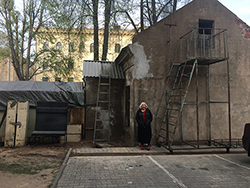 |
||
#minsk-97: Author and playwriter Laura shaine Cunningham by the old: Rabbi’s house behind theatre in Minsk (her play is often preformed in that theather and also in Russia) Laura's maternal grandfather Yosef (Joseph) Weiss was born in Kurenets Minsk region |
#minsk-98: | #minsk-99: |
|
|
|
Please share your comments or photos or links for posting on our Guestbook Page here: egl.comments@gmail.com
https://www.youtube.com/watch?v=tZx_8RSIMdc
Independence Square in Minsk, 8 23 2020. More than 200,000 people are chanting: "Leave! Leave!"
It would be a good idea for Lukashenko to listen to them.
Related Links
The
Minsk Ghetto
Minsk
- from The Jewish Encyclopedia
Belarus
Travelogue;
1880
Minsk Gubernia Vedomosti #1
BELARUS
NEWSLETTER
Belarus
in September, a ShtetlShleppers Trip to Minsk
Pre-1920 Minsk
Postcards
Article
on Minsk from the Jewish Encyclopedia, 1904
1930's
Minsk Chronicle Publication Committee (Minsker Pincos)
1894
- Family List of Jewish Town Dwellers of Minsk.
Jewishgen
shtetl page for Minsk;
Researchers
for Minsk
Journey to
Minsk: Index
U.S. Embassy Belarus
- U.S. Government Web Site about U.S.-Belarus Relations
Belarus
- city guide - In Your Pocket
Belarustourist - Hotels in Belarus, Visa support, Tourism
World
Jewish Congress; Minsk
Resistance
in Minsk
Minsk
Marriages
in Minsk in 1912, registered by Rabbi Khanelis
Minsk
School Records 1900-1917
Some
Words About Minsk...
Minsk, the capital of the Republic of Belarus, is an ancient city with rich history. It is 930 years in 1997 since the city was first described in the Story of Bygone Years chronicle as fortress of the Polotsk Principality associated with feudal battle on the Nemiga river in 1067. Minsk is the country's major industrial and cultural centre and one ofitsmost beautiful places. Just take walk in the centre of the city or go to the residential areas on the outskirts and you will see it for yourself. The city has acquired its peculiar look and colouring thanks to the well-planned avenues and squares, to the green ofthe parks and gardens stretching along the Svisloch river, to the historical monuments and the newly-built underground stations. Today's appearance ofthe city has developed due to many historical factors. Indeed, Minsk is situated right on the way from the West to the East. It has been many time destroyed by invaders and devastating fires and had to be rebuilt practically from scratch. It remembers the sanguine feudal wars, invasions of Mongol nomads and Tatar hordes whose ancestors had lived on the Belarus territory.
for the rest go to ;
http://www.geocities.com/RainForest/Vines/3954/minskhis.htm
Minsk
from The Jewish Encyclopedia, 1904
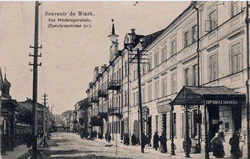
MINSK (formerly Mensk): Russian city: capital of the government of
the same name. Of the history of its Jewish community very little is
known. In 1576 King Stephen Bathori granted the Jews of Minsk the
privilege of engaging in trade or commerce of any kind. At the end of
the sixteenth century the Minsk Jews, sharing the lot of their
brethren in other parts of the country, were expelled from Lithuania.
In 1606, however, Jews are again found in Minsk, owning shops. In the
same year King Sigismund III confirmed the decree of expulsion; but
within ten years (1616) he annulled it, and reestablished the
privileges granted by Stephen Bathori. Moreover, in 1625 Sigismund
granted the Jewish community permanent possession of the tracts of
land occupied by the synagogue and the cemetery. Subsequently (1629)
he permitted them to own stores: but they were not allowed to build
houses. King Ladislaus IV, in response to a petition of the Minsk
Jews, confirmed the privileges granted by his predecessors. In
addition he allowed them to "acquire lots and to build shops on them,
as well as to buy old shops." They were still precluded from building
houses, though they might own such if they came into their possession
for debts. Lidislaus also left in their possession the brick-built
synagogue, which he exempted from taxation; and he gave permission for
founding a new Jewish cemetery.
In 1629 the superior of the Minsk Monastery of Peter and Paul brought
before the civil court a complaint against the Jews of Minsk, charging
them with having attacked the monastery during the baptism of a Jew.
In 1648 another complaint of a similar character was made. On this
occasion the waywode severely reprimanded the Jews, threatening them
with prosecution if such a thing should again occur. In 1670 King
Michael ordered the Minsk judicial starost not to allow unauthorized
officials to judge the Jews and not to hinder the latter from
appealing to the king or to the royal court, as they were subject only
to the jurisdiction of the starost. During the second half of the
eighteenth century the taxpayers of the Minsk Jewish community
repeatedly sent representatives to the chief Lithuanian exchequer
court in Grodno with complaints against the elders of the Minsk kahal.
The elders were charged with depleting the public revenues and with
defrauding the taxpayers among the middle classes.
On Jan. 1, 1896, the Jews of Minsk numbered 43,658. There were about
forty synagogues and numerous houses of prayer. Five of the
synagogues belong to the Jewish community, the others being controlled
by separate congregations of belonging to private individuals. Among
the numerous yeshibot the more important are: Blumke's yeshibah, the
Little Yeshibah, and the yeshibah at the Synagogue of the
Water-Carriers. The personnel of the Talmud Torah consists of eight
"melammedim" and four instructors in general subjects; out of the 334
pupils only 106 studied these subjects. The expenditure of the Talmud
Torah amounted to 4,355 rubles (1885). In 1879 a Jewish trade-school
was established in Minsk with locksmiths' and carpenters' departments;
instruction was offered also in general subjects, in Hebrew, and in
religion. In 1885 the school had 112 apprentices, and it expended
5,912 rubles. The Jewish hospital, founded in 1829, has
accommodations for seventy patients; its expenses amounted in 1885 to
8,068 rubles. The Jewish poorhouse, with eighty beds, had an
expenditure of 5,356 rubles in the same year. Besides, there are many
charitable associations, of which the more important are: a society
for the assistance of students of the Talmud, with an expenditure of
3,000 rubles (1885); a society for the assistance of the indigent
sick, with an expenditure of 1,500 rubles (1885), and a society
(founded about 1820) for the distribution of bread among the poor,
with an expenditure of 3,310 rubles (1884).
M.R.
The following are the names of Jews of Minsk who obtained particular
prominence:
District Rabbis
Moses Zeeb b. Judah, author of "Kol Yehudah."
Menahem Mendel, son of the preceding.
Asher b. Lob, tosaflst.
Isaac Abraham (held office 1749-55; d.1776)
Raphael b. Jekuthiel Lifander (1756-66).
Samuel of Indur (held office till 1777, when the district rabbinate
was abolished by the government).
Local Rabbis
Moses (d.1696), son of the martyr Mordecai, who was killed in Lublin
Aug. 11, 1636.
Lob Ba'al ha-Tosefot (d. about 1708).
Lob b. Asher, author of "Sha'agat Aryeh."
Jehiel b. Solomon Heilprin (d. about 1742), author of "Seder ha-Dorot."
Moses b. Jehiel Heilprin, succeeded his father about 1744.
Joseph b. Simhah Rapoport.
Gershon Harif (1778-93).
Israel b. Lob Mirkes (d. about 1813).
Samuel Segal (d. Dec.27, 1818).
Israel b. Hayyim Heilprin (d. 1836)
Isaac b. Naphtali Hirz Pines (d. 1836), chief of the bet din.
Judah Lob de Boton, son-in-law of Isaac Abigdor, author of "Pardes
Rimmonim."
Zeeb Wolf b. Moses (dayyan; d. 1848).
Judah Lob b. Abraham (d. 1851)
David Tebele b. Moses, author of "Bet Dawid" (d. 1861)
Moses Zebi, appointed rabbi by the government.
Moses Samuel Pines (d. 1862), chief of the bet din.
Baruch b. Zebi, dayyanim.
Saul b. Solomon, dayyanim.
Hayyim Lipschitz, dayyanim.
Joel Harif, dayyanim.
Aryeh b. Jacob (d. 1866), chief rabbi; author of "Be'er Heteb."
Moses Judah Lob (d. 1889), son-in-law of David Tebele.
Jeroham Judah Lob Pearlman ben Solomon, Russian rabbi; born in Brest
1835; died in Minsk 1896. He was one of the greatest rabbis of his
time, and was surnamed Gadol" (great one) on account of his prominence
in the world of Talmudical scholarship. At the age of thirty he
became rabbi of Seltz, near Brest, where he remained till 1871, when
he was called to occupy the office of rabbi in Pruzan, government of
Grodno. After the death of the two rabbis of Minsk, R. Gershon Tanhum
and R. Aryeh of Umen, the congregation of that city decided to appoint
him as its rabbi (1883); and he occupied the rabbinate till his death
(Benzion Eisenstadt, "Rabbane Minsk wa-Hakameha," pp.24,62, Wilna,
1899).
Eliezer Rabinowitz, chief rabbi.
Isaac b. David Tebele, assistant rabbi.
Jacob b. Meir, assistant rabbi.
Abraham Haneles, appointed by the government.
Presidents of the Yeshibot
Aryeh Lob b. Zebi Horwitz, author of "Margenita Taba."
Aryeh Lob b. Asher, author of "Sha'agat Aryeh."
Raphael b. Jekuthiel.
Joshua Heshel, author of "Mazimiah Yeshu'ah" and "Yushu' be-Rosh";
died in Jerusalem.
Dob Isaac b. Sebi Meir (d.1851).
Israel Michael Jeshurun (d.1851).
Abraham b. Joshua Evenzik (d.1859).
Issachar Bar, surnamed "the diligent" ("Masmid"; d.1879).
Gershon Tanhum b. Elijah Benzion (d.1881).
Solomon b. Saul Levin.
Mandel, instructor at the yeshibah
Ber of Krasni, instructor at the yeshibah
Abraham b. Asher Anshel, author of "Ammude ha-Yemini."
Prominent Preachers
Moses b. Judah, author of "Eben Shoham," who was later (1764)
appointed preacher in London, where he published that work.
Israelit, Israel Asher b. Ozer, Russian preacher; born about 1806;
died in Minsk June 6, 1896. He was popularly known as the "Grodnoer
Maggid" and was the preacher of the Jewish community in Minsk for more
than fifty-five years. Besides being an able preacher he was an
indefatigable communal worker and very charitable. His simple life
and his untiring exertions in behalf of the poor endeared him to all
classes of the population. Numerous stories are still related in
Minsk about his merciful exertions to release men who were unjustly
impressed for military service in the last years of the reign of
Nicholas I. as "poimaniki" or substitutes for others ("Ahiasaf," 5696,
p.312).
Abraham b. Zechariah Hamburg.
Joshua Isaac b. Jehiel, author of "Emek Yehoshua'."
H.R.
P. WI.
Authors, Scholars, and Others
Bampi, Issachar, author of a book "on Jewish customs."
Broyde, Aaron (d.1897), one of the directors of the Government Bank at
Minsk; he was honored with various medals.
Eliasberg, Judah Bezaleel (d.1845).
Eger, Samuel, son of Akiba Eger.
Jolles, Isaiah Zechariah (d.1853), author of "Et le-Dabber" and "Dober
Mesharim."
Kaplan, Jacob, corrected and added notes to the "Erez Kedumim."
Levanda, L., Hebrew-Russian writer.
Luria, Jacob Aaron, honored by Nicholas I. with a medal for useful
work in the Jewish community.
Luria, David, son of the preceding; conributor to the Hebrew
periodicals of his time.
Libowitz (1758-1853), the miracle-worker; an intimate friend of Elijah
Wilna.
Maskileison, Abraham b. Judah Lob (d.July 19, 1848), author of "Maskil
le-Etan" and other works.
Maskileison, Naphtali (d.1898), son of the preceding; publisher of the
"Seder ha-Dorot," with his own critical notes and additions.
Menahem Eliezer b. Levi (d.1817), author of "Ya'ir Kinno."
Rabinowitz, Eliezer Lipman (d.1887), an eminent Talmudic scholar, and
owner of a famous library.
Rapoport, Jekuthiel Sussel (d.1872), member of the rabbinical
committee appointed by the government.
Solomonov, Mordecai (d.1897), author of many novellae on Talmudical
subjects.
Solomon, Menahem b. Elijah, author of novellae on all parts of the
Talmud.
Pioneers of "Haskalah"
Brill, Joseph, Hebrew writer.
Haneles, Abraham, rabbi appointed by the government.
Horowitz, poet.
Kaplan, Israel, author of "Le-Torah we-Da'at."
Nofet, J. Zeeb, superintendent of the Jewish trade-school.
Sirkin, Joshua, prominent Zionist.
Sirotkin, Abraham, author.
Wohlman, Israel Mendel, ex-editor of the "Ha-Kokabim."
Philanthropists
Blimowitz, Bar; Eliasberg, Lipman; Eliasberg, Samuel Jonah; Ettinger,
Hillel; Goldberg, David; Jolles, Zusman; Luria, Hayyim; Luria, Samuel;
Pollak, Benjamin; Pollak, Moses; Ragovin, Uriah; Rapoport, Akiba;
Simhowitz, Mordecai; Sliasberg, Solomon; Solomonov, Moses Zebi;
Zeldowitz, Bar; and Zeldowitz, Baruch.
H.R.
N.T.L.
typing courtesy of Allyson Shames
Minsk Videos
Soviet armies surrounded in Bialystok-Minsk region(Jul 1941)
http://www.youtube.com/v/K3wHCI3JVT8&hl=en&fs=1
THE JEWESS AND CAPTAIN Shultz - LOVE IN THE GHETTO
http://www.youtube.com/v/V2YuRa4swJc&hl=en&fs=1
Minsk Jewish Campus Mazel Tov Children's Chanukah Concert
http://www.youtube.com/v/GzWwSzaDgng&hl=en&fs=1
The Eastern Front
http://www.youtube.com/v/dFRrmA5NcuA&hl=en&fs=1
Red Army Victory Parade
http://www.youtube.com/v/I4xgYsNVDdc&hl=en&fs=1
Minsk, Belarus
MINSK, Belarus
Other names: Mensk, Minskas, Miensk
http://www.shtetlinks.jewishgen.org/minsk/minsk.html
Camp on Wheels in Minsk, Belarus
?amp on Wheels is a unique model of a summer camp that combines volunteer work with an educational tour of Jewish sites. Such a camp is only possible in the former Pale of Settlement, now Belarus, Moldova, Ukraine and Lithuania, because of the Jewish life that once flourished there.
Now in its sixth year, Camp on Wheels attracted approximately 100 participants (students and young adults) from all over Belarus this past July. Camp of Wheels is run jointly by the Jewish Agency and Hillel. This August, a pilot based on Camp on Wheels was held in Moldova.
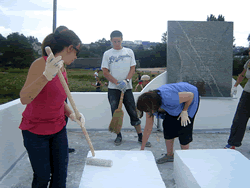
Guests from the Jewish Federation of Greater Atlanta during the visit to Camp on Wheels
The camp always begins with an intensive two-day educational seminar where participants learn about the Jewish legacy of the local area and listen to lectures on subjects ranging from synagogue architecture to deciphering tombstone inscriptions. The teachers are all Russian speaking experts and professors. For example, one of the teachers is an expert on epitaphs on Jewish tombstones and Jewish cemeteries in the Pale of Settlement.
This summer, the first term of Camp on Wheels focused on renovating the Jewish cemetery in Volozhin. Volozhin is the site of one of the most prominent yeshivas of Lithuanian (non-Chassidic) Judaism. The Jewish community of Volozhin and the yeshiva peaked in the 19th century and was already in decline by WWII. Under Nazi occupation, the Nazis mercilessly executed the Jews of Volozhin and extinguished any remnant of Jewish life. Today, there are only a few Jews living in Volozhin and none was born there.
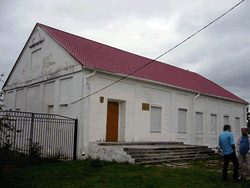
The famous Volozhin yeshiva overlooks the cemetery
Before the campers tended to the cemetery it looked like a large overgrown field with tombstones here and there, and a large memorial tombstone for R. Chaim of Volozhin in the middle that was falling apart.
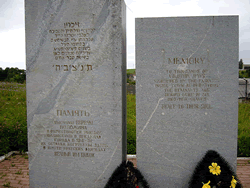
A memorial for the Jews of Volozhin who perished in the Holocaust
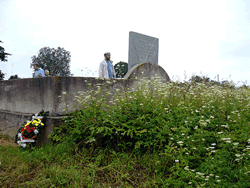
Large memorial tombstone of R. Chaim Volozhiner
Today, thanks to the campers and other volunteers, the site of the cemetery has been mowed and the gravestones carefully catalogued for further research. The fence around the cemetery and R. Chaim Volozhiner's grave have been restored and repainted.
In previous years, Camps on Wheels focused on renovating historic synagogues and yeshivas. Each year, campers stay in very simple accommodations and work under the supervision of experts, applying the skills they learned from a pre-camp seminar. After a few days of work the students embark on an educational tour of Jewish heritage sites and former shtetls, covering five locations each day. An educational component is connected to each site. The program of this year's Camp on Wheels takes the participants from destruction (abandoned cemetery in Volozhin) to rebirth (a synagogue in Grodno that is being rebuilt).
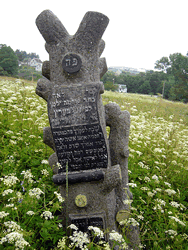
Tree of Life Tombstone with the branches cut off
Participation in Camp on Wheels makes a profound impact on participants. A powerful educational tool, the camp connects students to what is essentially their family history in a very direct, hands-on way. Many participants have gone on to do genealogical research after the camp, discovering previously unknown family stories and sharing them with other participants. Some campers got a head start on Hebrew while deciphering epitaphs, and today speak fluently. Others have found friends for life. All of them connected to a shared heritage and a common past, and are now strengthened in building a common future.
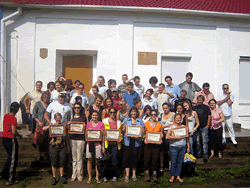
Group shot of Camp of Wheels participants and the delegation of the Jewish Federation of Greater Atlanta
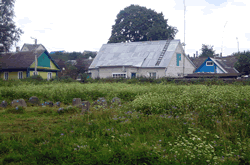
The Jewish cemetery in Volozhin before the Camp on Wheels participants' hard work and renovation.
If you would like to know more about Camp on Wheels, or other Jewish Agency summer camps, please contact Anya Zhuravel at anyaz@jafi.org
Jewish families who moved to Birobidjan from (Soviet) Belarus in 1929.
https://jhrgbelarus.wordpress.com/2016/01/20/1929-jewish-families-from-belarus-move-to-birobidjan/
